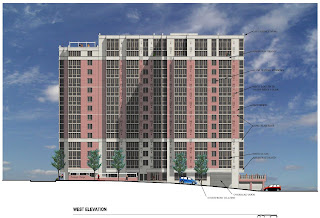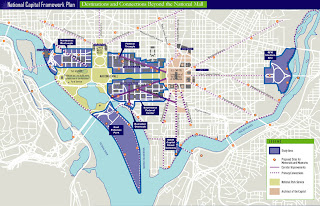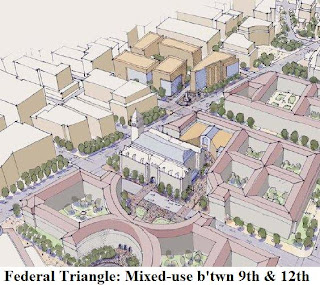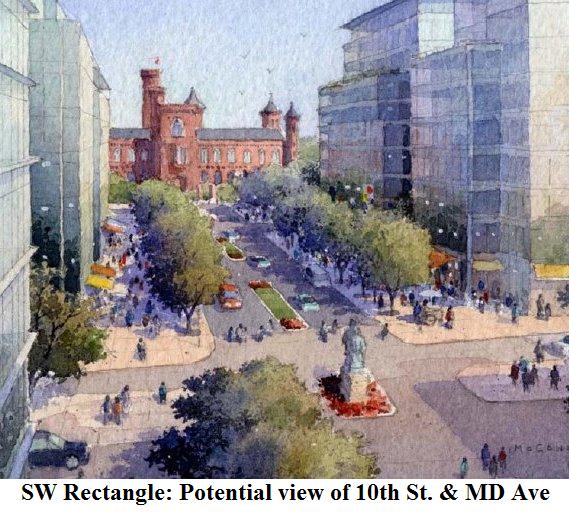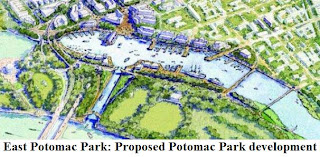Since its' inception in 1999, the SK&I Architectural Design Group has been one of the go-to names for striking, sophisticated  architecture in the DC area. With mixed-use projects like Wisconsin Place in Friendship Heights, Union Row in Columbia Heights and an upcoming slate that includes Lot 31 in Bethesda, and the Washington Gateway and Constitution Square in NoMa, their designs will soon be more prominent than ever. Sami Kirkdil, President of SK&I, and Meral Iskir, Executive Vice President, took the time to sit down with DCMud and talk about their approach to architecture, the current effects of the housing market on an architectural firm, and what the District might look like a few years down the line.
architecture in the DC area. With mixed-use projects like Wisconsin Place in Friendship Heights, Union Row in Columbia Heights and an upcoming slate that includes Lot 31 in Bethesda, and the Washington Gateway and Constitution Square in NoMa, their designs will soon be more prominent than ever. Sami Kirkdil, President of SK&I, and Meral Iskir, Executive Vice President, took the time to sit down with DCMud and talk about their approach to architecture, the current effects of the housing market on an architectural firm, and what the District might look like a few years down the line.
How did you get your start in architecture?
MI: I originally studied back in Turkey and then studied again here at
Catholic University. I’ve continued to work steadily since I initially came here 40+ years ago. I spent some years with
CHK, then Sami and I started this firm. We’ve been doing all kinds of architectural projects and just working, working and working.
SK: I think my introduction to architecture was through my father’s friend – an architect friend. When I was a kid, he used to do sketches of buildings and give them to me, and that kind of intrigued me. I was basically good at math, science and art, so I thought, “Hey, this might be the thing for me” in high school. I knew what I wanted to do, so I went to college and have been practicing for the past 25 years.
I think that you are the mo

st happy when you’re working hard and designing. Obviously, there’s a lot of red tape and a lot of things that you have to do, but designing and doing a project is the fun part of it. I think that’s what drives us towards the future. Somewhere along the line our specialty became mixed-use, residential design. In the last 8 or 9 years, we’ve done a lot of big residential projects. It was just the right time and the right place. There weren’t that many firms focusing on residential and we’ve had a head start on that game. We’ve grown from a two person firm to a 50+ person firm. We’ve kept that steady, but didn’t want to grow out of control and maybe lose the quality of our work.
What kinds of projects appeal to you personally and, by extension, your firm?
SK: Generally, our cup of tea is more complex projects that play in the urban realm, fit into the neighborhood and create a nice home for the people who live in it. There are always new ways to put together interpretive designs with the way buildings go together, basically.
How would you typify the developer /architect relationship? Are some harder to please than others?
SK: We might be a little different than a lot of other firms. I think our expertise is that we understand the development process as well the developers. Basically, what works and what doesn’t work. We can reason with them when it comes to what design ideas might propel them in a specific area. They don’t necessarily have to educate us; sometimes we try to guide them. We want to become their partners. We want to understand their theme and their dilemma. We want to give them an edge.
MI: Of course, our position allows us to work with different developers. This is kind of an advantageous position in the sense of understanding and thinking about a project through our own experience. It kind of enriches our understanding of what goes on in the market and allows us to show leadership through our designs. We’re not doing the architecture for ourselves, but for our clients. At the same time, we can control the quality and accomplish the best we can within the given conditions.
If you change one thing about the DC development process, what would it be?
MI: Getting to a better place where there is an appreciation for the architect’s efforts. That is lacking in general, as far as I’m concerned.
SK: Well, there are good things and bad things about building height. I think that’s one thing that would be good to look at. There are some instances where it creates a very walkable city. On the other hand, architecture becomes challenging when everything’s 13 or 14 stories. It couldn’t be a bad idea to have more height in some locations. I think, given that our resources are now more limited, we have to densify our cities. To me, densifying

the city, outer suburbs, or Metro locations with higher height and higher density is probably something that would be good for Washington.
On that note, you built Union Row above a Metro station. What kind of challenges did that pose?
SK: Lots, actually. Part of the problem with that site was that it was an assemblage – a bunch of little pieces. But our real plight was the Metro tunnel running from 14th Street and curving down towards 13th Street. That part of the site we couldn’t actually build on. What we did was have the building’s shape follow the route and then we put our girders and columns right along it. We could only put two levels of parking there, while the rest was three levels. It was a long, lengthy process of getting approval from Metro and testing and excavation.
MI: In addition to that, we also had to provide access to the existing warehouses that were there – in addition to upgrading and renovating them. We tried to create a kind of plaza-like structure there. I think we were successful in the view from the main street and were able to manipulate the design in such a way that it gets your attention.
You have also been contracted for one of the largest projects in NoMa (Constitution Square). Can you give us a bit of insight into how NoMa might look in, say, 5 years?
SK: Well, instead of 5 years, let’s say 10 years. I think, potentially, people are wishing for the same thing that happened to Chinatown. We were there 9 years ago with Massachusetts Court at 4th and Mass and couple of other projects that did not go through. Today, if you look at Chinatown, they have all the nicest restaurants in the city. In a way, it’s surpassed DuPont, northwest Connecticut Avenue, in terms of pizazz.
NoMa wishes that they’ll be seeing the same quality and caliber of that development. Obviously, the Verizon Center and all that retail is a big advantage and we want to see similar kinds of things in NoMa.
The project we’re doing is mixed-use – an office building, a hotel, a
Harris Teeter grocery store and apartments. The hope is to create a critical base of retail, residential and office space, so that you’re not building up an area that shuts down at five o’clock. Since 2000, if you look at the city and our projects, we are trying to create a 24-hour living space that has a life cycle with offices and retail. You’re not necessarily commuting; you’re living, shopping and working

in the same place. You’d hope that NoMa becomes that.
MI: I think the fundamental approach is understanding how neighborhoods and areas stay alive, rather than just a being a place to go to in the daytime and empty in the nighttime. I think they want a good foundation for a better future this time.
How much work do you do outside the metro area?
SK: We have done international work over the years and, if you look at our career, we’ve done all that stuff. If you look at the past 9 years, we were really busy and did not want to grow. We used to turn down almost 20% of the work that came in the door. We were cherry-picking the projects that we’d do. Obviously, circumstances have changed, so we’ll probably be looking at doing projects outside the area. We’ve done projects up and down the East Coast from Miami to Boston.
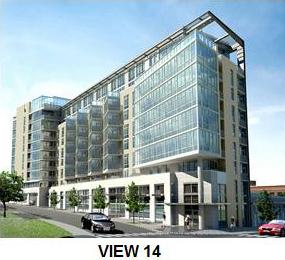 MI:
MI: We were involved with many projects outside the area, for example,
Harbor East in Baltimore. We did an 18-story project there that was mixed-use – again, with retail.
How does the current economic situation affect an architecture firm?
SK: I’m sure the whole development world is living on fumes. Obviously, with the current financial market, there’s very little money available. There are two things going on. There are great projects that have secured financing to do private work; and there is some entitlement work that will go forward. People are hoping that the market will turn around and it’s that optimism that’s the driving force. I’m sure there will be a great opportunity to have any kind of product out there in a year or two. Once the economy turns back, the first people out of the gate will make out the best. Once the market steams up, you jump in to catch a piece of it. We have some clients that are in a cycle where they’ll be delivering in 2011, 2012, 2013 and they’re hopeful that their financing is intact. Other clients think the market is going to shrink. And it is shrinking because the capital behind what you can finance is zero. We are hearing it every day, it’s tough out there. We’re going to see a lot more competitive pricing. For the first time since we’ve opened our doors, we’re actually out there chasing RFPs.
MI: Generally, lots of architecture firms are actually shrinking. At the time, some of the other ones are looking abroad to the Middle East and so on. But everyone’s affected.
What was the most challenging project you’ve ever worked on?
SK: I think every project’s a challenge. Our specialty is – even though we’re a mid-size firm – we tackle really complex projects. One of our projects that’s under construction, Wisconsin Place, had basically three or four different teams. The garage was done by different architect and structural engineer and parts of the building were done by another architect and structural engineer, so there was a lot of interface coordination and collaboration between all these different teams. A “who does what?” type of deal, so Meral championed that effort and it took us a while. We had to wait for other firms to finish their work.
The other project we’re currently working on is going to be very complex -
Lot 31 in Bethesda, which is now two parking lots across from
Barnes & Noble. There was a very complicated

entitlement process and we’re now full throttle in the design process. It’ll take a while to get it built because what we’re doing is, basically, taking Woodmont Avenue away [laughs]. We’ll be digging into the rock for five levels and building a column-free garage. Then, we’re doing a 9-story building on one side and a 5-story building on the other.
MI: Thinking about it while Sami was talking, I think every project has its’ own challenges. You have to try to design it in such a way that the building will look unique, but still serve the neighborhood and be able to get through the approval processes. You have to work with the contractors and combine with the developer’s needs to make the project as successful as it could be. I don’t want to sound conceited, but I think our experience is such that we are good listeners and can point any issues before they become a problem. It forces us to make every project a 360 degree success.
Every project has its’ own unique expectations and character. They’re like your children. Every one of them has a different personality and the challenge is having happy and successful children, in a certain sense.
If you could work on any project, what would it be? A dream project...
MI: Is there such a thing as a dream project? Human beings always change and what you liked yesterday could change tomorrow. When I look back at some of the projects I’ve done, I liked them then, but not necessarily today. At the time you might think of it as a dream project, but tomorrow you could always say, “Was it really?”
SK: It’s tough, but the kind of project that allows me to be wild and think freely is a dream project. That said I can’t design a house for myself because I’m my own worst critic. When it comes to designing your own thing, it’s not easy. I’m very deliberate and straightforward in designing projects for others. For myself, I’m terrible because I want to accomplish much more than I can handle – the program, the aesthetics, the budget. If you design something today and look back at it in a few months, you might say, “No, maybe that wasn’t the right thing to do.” Your tastes change. It’s a process that keeps your brain sharpened.
Washington DC commercial real estate news
 The District announced a new plan today to kickstart redevelopment of the old St. Elizabeths mental institution in Ward 8. If approved by the District Counsel, the series of projects will beef up one of DC's poorest neighborhoods with nearly 3 million square feet of mixed-use development. Mayor Adrian Fenty, Congresswoman Eleanor Holmes Norton, and Office of Planning Director Harriet Tregoning
The District announced a new plan today to kickstart redevelopment of the old St. Elizabeths mental institution in Ward 8. If approved by the District Counsel, the series of projects will beef up one of DC's poorest neighborhoods with nearly 3 million square feet of mixed-use development. Mayor Adrian Fenty, Congresswoman Eleanor Holmes Norton, and Office of Planning Director Harriet Tregoning  were on hand today to announce the release of the St. Elizabeths East Redevelopment Framework Plan, which recommends transforming the hospital’s eastern, District-owned flank into five neighborhoods, "each with their own character," and pushes for the Department of Homeland Security's (DHS) proposed relocation to federally-controlled St. Elizabeths West. The government transferred ownership of the eastern portion to the District in 1987, while retaining the western campus for its own use.
were on hand today to announce the release of the St. Elizabeths East Redevelopment Framework Plan, which recommends transforming the hospital’s eastern, District-owned flank into five neighborhoods, "each with their own character," and pushes for the Department of Homeland Security's (DHS) proposed relocation to federally-controlled St. Elizabeths West. The government transferred ownership of the eastern portion to the District in 1987, while retaining the western campus for its own use.





























